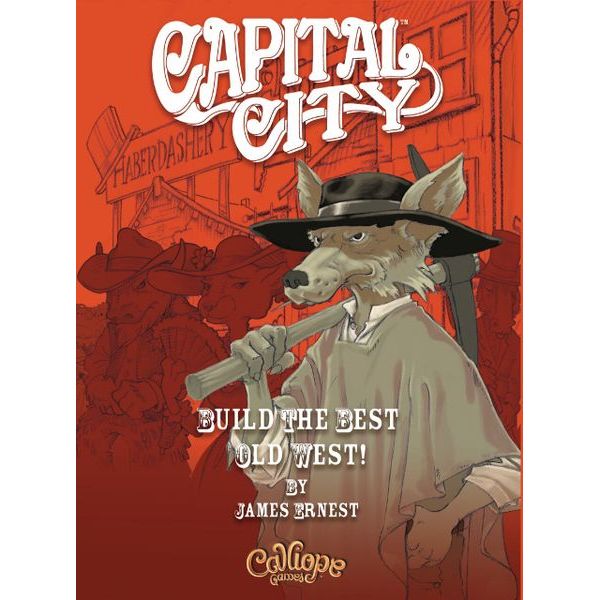Bid, Draft, and Build in Wild West Game Capital City

Who’ll be mayor in this Wild West town? Create businesses, staff them with newcomers, and create a bustling town to win the top job.
Published by Calliope Games and designed by James Ernest (founder of Cheapass Games and designer of Kill Doctor Lucky and Pairs), Capital City has bidding, drafting, and set collection, mixed in with lots of player interaction and a Wild West theme.
Gameplay
You start the game by dealing each player one character card. Characters come from different families, each represented by a different color of card back. The number of families used in a game varies based on player count.
Each round of the game is one season of the year. You set up the season by drawing a number of character cards to represent a train of passengers. These cards are kept face-down on the table. Some seasons may have more than one train. A train consists of character cards equal to the number of players plus one. Also, each season tells you how many building cards to draw and place face-up on the table.
Next, players take turns bidding on turn order cards. You start bidding on last place and work your way up. When the bidding comes to you, you can either bid one coin or you can take the current turn order card and all the coins currently bid on it.
Once each player has a turn order card, the player with the first place card goes first. He looks at all the character cards in the train, selects one, places it face-down in front of himself, and passes the train to the next player in turn order. Each player takes a turn selecting a character. Once the final player has chosen one, the last character card is discarded. If there is more than one train that season, you do the same with the next train.
During the next phase of the round, starting with the first player, everyone can choose one building to buy, paying the cost shown on it. When you buy a building, you place it in front of yourself face-up. If you do not or cannot buy a building, you can skip this phase and take five coins from the bank. Any buildings not bought are discarded.
The next phase is the attachment phase, which is performed in reverse turn order. Starting with the player with the last place card, players take turns attaching character cards to their buildings. Each character card shows half of one of three icons. In order to attach a character, its half symbol must match the half of the symbol on the building card.
Some buildings have slots for two characters, while some only require one. All a building’s slots must be completed for the building to be considered filled. When a building is filled, it activates. When activated, you choose whether to collect the coin amount shown on the building or the victory points shown. Next, you look at the family color of the card you played that activated this building. You then activate each character card you have which is a member of that same family and that is attached to a filled building, collecting that building’s reward. Next, each other player may activate one character of that family that is attached to a filled building of theirs.
You may attach as many or as few characters as you wish during the phase. But once a character is attached to a building, it cannot be moved to another. Any characters you have that you do not attach, you keep face-down in front of you.
Players then return their turn order cards and prepare to start a new round.
At the end of four rounds, players count up all their victory points. Ten coins are worth a single victory point. The player with the most points wins the game.

Review
Each choice you make in Capital City has several elements to consider, many of them affecting not just yourself but your opponents as well. The gameplay is layered without being overly complicated, and there is plenty of player interaction.
Players have to choose carefully when to take the money from a building and when to take the victory points. Running out of money can be problematic, as it forces you to miss acquiring a building, but ultimately those victory points are what you need to win the game.
It’s also clever that while you want to have lots of cards from a single family (so that you can have some big payouts when activating all of them on one turn), the odds are a lot lower that another player will activate that same family on their turn, so you need to weigh the pros and cons each time you choose which character card to draft and what families to play. We also enjoyed the fact that going first is not always the most desirable option. Sometimes it can be just as lucrative to go first in the attachment phase of the round.
The theme is fun, although the artwork on the game isn’t the most exciting. Also, the game shines most when there are more players so that more buildings are getting triggered by everyone each round.
All things considered, the elements of this game blend together into a clever card game with a great sense of escalation as more and more cards come out onto the table and more buildings are triggered each round.
Pros: Lots of player interaction, lots of layers to each choice, great escalation
Cons: Artwork could be more exciting, better with more players
Disclosure: we received a complimentary review copy of this game.







